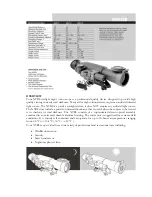
4
washers (H), and small wing nuts (I) provided. Place a
washer on the screw. Then place the accessory tray on
top of one of the leg braces so that the mounting screw
passes through the hole at one of the corners of the
accessory tray, and through the slot in the leg brace. Then
place another small washer on the screw and thread on
and tighten the wing nut. Repeat this procedure until the
tray is attached to all three leg braces.
The tripod is now fully assembled
(Figure 6). Next you will
install the equatorial mount onto the tripod.
5. Locate the equatorial (EQ) mount (J) and place its base into
the hole in the center of the mounting platform (Q) (
Figure
7a). Then secure it in place with the azimuth lock knob and
washer (K) (
Figure 7b).
6. Thread the latitude adjustment bolt (L) into the threaded
socket (
Figure 8) until it contacts metal inside the housing.
7. Next, thread the counterweight shaft (M) into the base of
the Declination axis of the mount
(Figure 9).
8. Thread the counterweight lock knob (N) into the counter-
weight (O) a few turns.
9. To slide the counterweight onto the counterweight shaft,
first remove the Philips screw and washer from the end of
the shaft. You can use the screwdriver tool (T) for this. Make
sure the counterweight lock knob (N) is loosened enough
so that the metal pin inside the counterweight is clear of
the shaft hole. Slide the counterweight about 2 inches from
the bottom of the counterweight shaft and secure it in place
with the lock knob (
Figure 10). Then replace the washer
and screw at the end of the counterweight shaft.
10. Attach the slow motion cables (P) to the gear shafts as
shown in
Figure 11. The longer cable should be attached
to the declination gear shaft; the shorter cable to the right
ascension gear shaft. Orient the cable so that the thumb-
screw seats in the groove of the gear shaft, as shown in
Figure 12, then firmly tighten the thumbscrew. If there is
a small rubber ball on the end of the shaft, you will have
to remove it in order to attach the cable. Also note that,
depending on your preference, you can attach the cable to
either the left or right side of the right ascension gear shaft.
Now the mount is properly attached to the tripod and outfitted
for use (
Figure 13). Next, you’ll attach the tube ring and opti-
cal tube to the EQ mount.
11. To attach the tube ring (R), set the bottom of the ring into
the EQ head’s saddle and bolt it on with the two supplied
socket head bolts, washers, and wing nuts (S) as shown
in
Figure 14. You can use the supplied Allen wrench (Z,
not shown in Fig. 1) to help tighten the bolt while holding
the wing nut. Do not overtighten!
12. Then lay the telescope optical tube (U) into the open tube
ring. Close the tube ring around the tube and tighten the
tube ring clamp knob. The telescope should now look like
Figure 15.
13. To attach the red dot finder scope (V) to the optical tube,
orient the finder scope as shown in
Figure 16 and slide
the bracket foot into the finder scope base until it clicks.
Figure 3
. a)
Attach the three tripod legs to the mount platform,
b)
making sure the bolt’s hex-shaped head seats in the hex-shaped
recess of the tripod leg.
Washer
Wingnut
Figure 4.
Thread a leg lock thumbscrew onto each tripod leg as
shown, being careful not to overtighten.
Figure 5.
Attach the accessory tray to each of the tripod three
leg brace supports using the provided hardware.
Wing nut
Accessory tray Screw head
Washer
Washer
Leg





























